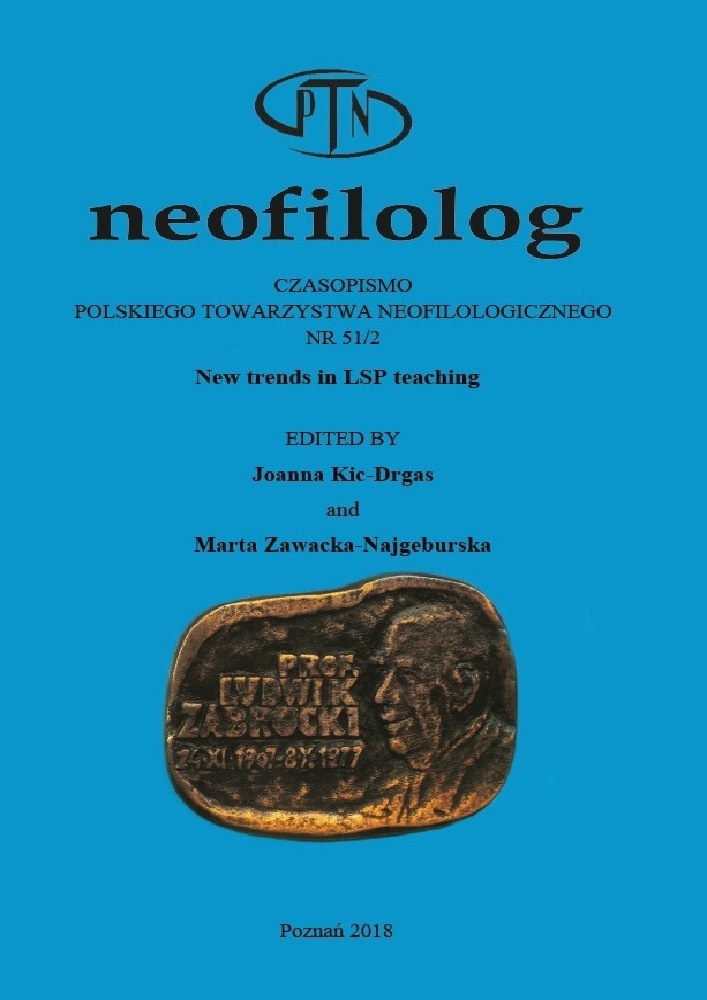Abstract
The article explores the influence of the specialised language on the shaping of the image of the German car brand Volkswagen. The analysed material comprises marketing texts from an image magazine of the Volkswagen Magazin brand, available on the company’s website. The issue will be examined on the basis of the semantic category of Electro Mobility, which constitutes a subcategory of the semantic category of innovation, which in turn is currently the company’s main area of activity and the focus of all actions, also linguistic, in terms of shaping the brand’s image. The specialised language in the texts from the Magazine, a digital journal, whose articles resemble forms of journalistic writing, limits itself mainly to specialist vocabulary – the technical vocabulary referring to automotive technology, as well as pseudo-specialised language, whose role is merely to evoke technical connotations. Both types of specialist terminology contribute to the restoring of the reputation of the brand in the eyes of the consumers, which has been severely affected as a result of the emissions scandal in 2015.
References
Bastian S., Koppe K., Lenk, M., Noack, S. (2000), Nanocapsule de vitamine E pure”, „Double Sérum 38“, „l'élimination des bactéries de la vaisselle...? Vom Sinn und Unsinn fachsprachlicher Mittel in der „Werbung“ (in) Morgenroth, K. (Hrsg.), Hermetik und Manipulation in den Fachsprachen. Tübingen: Narr Francke Attempto, S. 83-106.
Filip G. (2014), Personifikacja jako sposób brandingu VW na rynku polskim na przykładzie. „Volkswagen Magazyn” i „Das Auto. Magazyn (in) Мартинова Г.І. (Hrsg.), Мовознавчий Вісник. Збірник наукових праць. Випуск 19. Черкаси: Міністерство о Світи і Науки України Черкаський Національний Університет Імені Богдана Хмельницького, S. 154-160.
Fluck H.-R. (1996), Fachsprachen. Bern und München: Francke.
Gläser R. (1990), Fachtextsorten im Englischen. Tübingen: Narr.
Grucza F. (2008), Języki specjalistyczne – indykatory i/lub determinanty rozwoju cywilizacyjnego (in) Lukszyn J. (Hrsg.), Podstawy technolingwistyki I, S. 5-23.
Grucza S. (2013), Od lingwistyki tekstu do lingwistyki tekstu specjalistycznego. Warszawa: Wydawnictwo Naukowe Instytutu Kulturologii i Lingwistyki Antropocentrycznej.
Grünert H. (1984), Deutsche Sprachgeschichte und politische Geschichte in ihrer Verflechtung (in) Besch, W. u.a. (Hrsg.), Sprachgeschichte, S. 29-37.
Habrajska G. (2005), Nakłanianie, perswazja, manipulacja językowa (in) “Acta Universitatis Lodziensis Folia Litteraria Polonica”, No 7, S. 91-125.
Jakob K. (1991), Maschine, Mentales Modell, Metapher. Tübingen: Niemeyer.
Janich N. (1998), Fachliche Information und inszenierte Wissenschaft. Tübingen: Narr.
Janich N. (2001), Fachliches in der Werbung (in) Wichter S., Antos G. (Hrsg.), Wissenstransfer zwischen Experten und Laien. Frankfurt am Main: Lang, S. 257-274.
Janich N. (Hrsg.) (2009), Marke und Gesellschaft. Wiesbaden: Verlag für Sozialwissenschaften.
Kampker A. (Hrsg.) (2013), Elektromobilität: Grundlagen einer Zukunftstechnologie. Berlin: Springer Vieweg.
Lewicki A. M. (2002), Obraz samochodu w sloganach reklamowych (in) Anusiewicz J., Bartmiński J. (Hrsg.), Język a kultura, t. 12, Stereotyp jako przedmiot lingwistyki. Wrocław: Wydawnictwo Uniwersytetu Wrocławskiego, str. 206−223.
Ligara B., Szupelak W. (2012), Lingwistyka i glottodydaktyka języków specjalistycznych na przykładzie języka biznesu. Podejście porównawcze. Kraków: Księgarnia Akademicka.
Łuczak M., Małys Ł. (2016), Współczesne koncepcje i trendy w branży motoryzacyjnej. Poznań: Advertiva.
Morgenroth K. (2000), Die Alchemie in der Wissenschaft: fachsprachliche Hermetik und pseudofachsprachliche Manipulation – Zur Einführung (in) Morgenroth K., Die Alchemie in der Wissenschaft: fachsprachliche Hermetik und pseudofachsprachliche Manipulation (Hrsg.), Hermetik und Manipulation in den Fachsprachen. Tübingen: Narr, S. 9 – 40.
Ożóg K. (2001), Polszczyzna przełomu XX i XXI wieku: wybrane zagadnienia. Rzeszów: Wydawnictwo Stowarzyszenie Literacko-Artystyczne „Fraza”.
Wilczek W. (2016), Polski język motoryzacyjny początku XXI wieku. Katowice: Wydawnictwo Uniwersytetu Śląskiego.
License
Copyright (c) 2018 Neofilolog

This work is licensed under a Creative Commons Attribution-NoDerivatives 4.0 International License.
Authors
Authors of texts accepted for publication in Neofilolog are required to complete, sign and return to the Editorial team’s office the Agreement for granting a royalty-free license to works with a commitment to grant a CC sub-license.
Under the agreement, the authors of the texts published in Neofilolog grant Adam Mickiewicz University in Poznań a non-exclusive, royalty-free license and authorize the use of Attribution-NoDerivatives 4.0 International (CC BY-ND 4.0) Creative Commons sub-license.
The authors retain the right to the free disposal of the work.
Users
Interested Internet users are entitled to use works that have been published in Neofilolog since 2017, under the following conditions:
▪ attribution – obligation to provide, together with the distributed work, information about the authorship, title, source (link to the original work, DOI) and the license itself.
▪ no derivatives – the work must be preserved in its original form. Without the author's consent, it is not possible to distribute the modified work in the form of translations, publications, etc.
Copyrights are reserved for all texts published since 2017.
Miscellaneous
Adam Mickiewicz University in Poznań retains the property right as a whole (layout, graphic form, title, cover design, logo etc.).

